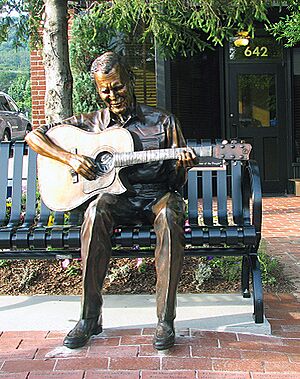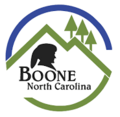Boone, North Carolina facts for kids
Quick facts for kids
Boone
|
|||
|---|---|---|---|
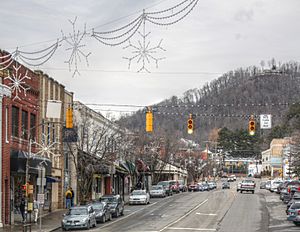
West King Street
|
|||
|
|||
| Nickname(s):
The Heart of the High Country
|
|||
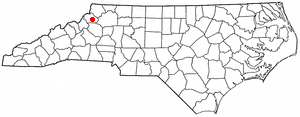 |
|||
| Country | United States | ||
| State | North Carolina | ||
| County | Watauga | ||
| Incorporated | 1872 | ||
| Named for | Daniel Boone | ||
| Government | |||
| • Type | Council–manager | ||
| Area | |||
| • Total | 6.35 sq mi (16.45 km2) | ||
| • Land | 6.33 sq mi (16.40 km2) | ||
| • Water | 0.02 sq mi (0.05 km2) | ||
| Elevation | 3,232 ft (985 m) | ||
| Population
(2020)
|
|||
| • Total | 19,092 | ||
| • Density | 3,014.68/sq mi (1,164.00/km2) | ||
| Time zone | UTC−5 (Eastern (EST)) | ||
| • Summer (DST) | UTC−4 (EDT) | ||
| ZIP codes |
28607-28608
|
||
| Area code(s) | 828 | ||
| FIPS code | 37-07080 | ||
| GNIS feature ID | 2405303 | ||
Boone is a town in North Carolina, United States. It is the main town in Watauga County. Boone is found in the beautiful Blue Ridge Mountains.
This town is home to Appalachian State University. It is also where the relief group Samaritan's Purse has its main office. In 2020, about 19,092 people lived in Boone.
The town gets its name from the famous explorer, Daniel Boone. Every summer since 1952, a play called Horn in the West is performed outdoors. It tells the story of how British settlers came to the area during the American Revolutionary War. Daniel Boone is a big part of this play. Boone is the largest town and a key business center in the "High Country" region of Western North Carolina.
Contents
History of Boone
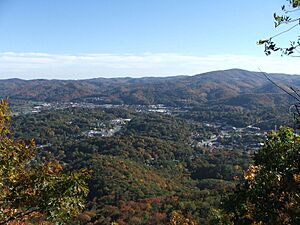
Boone is named after the famous pioneer Daniel Boone. He camped in this area many times. Daniel's nephews, Jesse and Jonathan Boone, were part of the town's first church. This church, Three Forks Baptist, is still here today.
A special small train called "Tweetsie" used to serve Boone. But a big flood in 1940 washed away many of its tracks. They were never replaced after that.
Boone is home to Appalachian State University. This university is part of the University of North Carolina system. It is the sixth-largest university in this system. Caldwell Community College & Technical Institute also has a campus in Boone.
The outdoor play "Horn in the West" shows the lives of early mountain settlers. Daniel Boone is one of the characters. It has been performed every summer since 1952, except for 2020. The first actor to play Daniel Boone was Ned Austin. His "Hollywood Star" is in downtown Boone. Glenn Causey played Daniel Boone for 41 years. His image is still seen in many places around Boone.
Boone also has a special place called the Junaluska community. This area, just north of downtown, has been home to a free Black community since before the American Civil War. Many descendants of the first residents still live there. Junaluska also has one of the few Mennonite Brethren churches for African Americans.
Boone is a hub for bluegrass music and Appalachian storytellers. Famous musicians from or linked to Boone include Doc Watson and Michael Houser. Other artists like Old Crow Medicine Show, The Blue Rags, and Eric Church are also from Boone.
Geography and Climate
Boone is very high up, about 3,333 feet (1,016 meters) above sea level. It is the highest town of its size (over 10,000 people) east of the Mississippi River.
Because it's so high, Boone has a cooler climate than other parts of the Southeast. Winters are long and cold, with lots of snow and sleet. Summers are warm but not as hot or sticky as lower areas. Boone gets about 25 inches (64 cm) of snow each year. The coldest temperature ever recorded was -24°F (-31°C) in 1985.
| Climate data for Boone, North Carolina (1991–2020 normals, extremes 1920–present) | |||||||||||||
|---|---|---|---|---|---|---|---|---|---|---|---|---|---|
| Month | Jan | Feb | Mar | Apr | May | Jun | Jul | Aug | Sep | Oct | Nov | Dec | Year |
| Record high °F (°C) | 78 (26) |
75 (24) |
81 (27) |
89 (32) |
87 (31) |
94 (34) |
96 (36) |
91 (33) |
92 (33) |
87 (31) |
80 (27) |
73 (23) |
93 (34) |
| Mean maximum °F (°C) | 60.1 (15.6) |
62.5 (16.9) |
69.9 (21.1) |
76.7 (24.8) |
80.2 (26.8) |
83.9 (28.8) |
85.6 (29.8) |
84.5 (29.2) |
81.3 (27.4) |
75.6 (24.2) |
68.1 (20.1) |
61.5 (16.4) |
86.9 (30.5) |
| Mean daily maximum °F (°C) | 41.4 (5.2) |
44.7 (7.1) |
51.7 (10.9) |
61.7 (16.5) |
69.4 (20.8) |
75.8 (24.3) |
79.0 (26.1) |
77.8 (25.4) |
72.2 (22.3) |
63.0 (17.2) |
53.0 (11.7) |
45.0 (7.2) |
61.2 (16.2) |
| Daily mean °F (°C) | 31.5 (−0.3) |
34.2 (1.2) |
40.5 (4.7) |
49.3 (9.6) |
57.6 (14.2) |
64.7 (18.2) |
68.4 (20.2) |
67.1 (19.5) |
61.3 (16.3) |
51.2 (10.7) |
41.3 (5.2) |
34.9 (1.6) |
50.2 (10.1) |
| Mean daily minimum °F (°C) | 21.6 (−5.8) |
23.8 (−4.6) |
29.2 (−1.6) |
36.9 (2.7) |
45.8 (7.7) |
53.7 (12.1) |
57.7 (14.3) |
56.3 (13.5) |
50.3 (10.2) |
39.3 (4.1) |
29.6 (−1.3) |
24.7 (−4.1) |
39.1 (3.9) |
| Mean minimum °F (°C) | 3.9 (−15.6) |
8.8 (−12.9) |
14.3 (−9.8) |
24.3 (−4.3) |
32.6 (0.3) |
43.6 (6.4) |
49.6 (9.8) |
48.5 (9.2) |
38.4 (3.6) |
26.2 (−3.2) |
17.6 (−8.0) |
10.2 (−12.1) |
1.5 (−16.9) |
| Record low °F (°C) | −24 (−31) |
−8 (−22) |
−6 (−21) |
13 (−11) |
24 (−4) |
33 (1) |
38 (3) |
33 (1) |
25 (−4) |
14 (−10) |
−6 (−21) |
−11 (−24) |
−24 (−31) |
| Average precipitation inches (mm) | 4.39 (112) |
3.64 (92) |
4.77 (121) |
5.52 (140) |
5.46 (139) |
5.59 (142) |
5.11 (130) |
5.56 (141) |
5.73 (146) |
4.69 (119) |
4.44 (113) |
4.23 (107) |
59.13 (1,502) |
| Average snowfall inches (cm) | 6.6 (17) |
6.7 (17) |
4.8 (12) |
1.0 (2.5) |
0.0 (0.0) |
0.0 (0.0) |
0.0 (0.0) |
0.0 (0.0) |
0.0 (0.0) |
0.3 (0.76) |
1.0 (2.5) |
5.2 (13) |
25.6 (65) |
| Average extreme snow depth inches (cm) | 4.3 (11) |
3.9 (9.9) |
3.4 (8.6) |
0.6 (1.5) |
0.0 (0.0) |
0.0 (0.0) |
0.0 (0.0) |
0.0 (0.0) |
0.0 (0.0) |
0.2 (0.51) |
0.7 (1.8) |
3.8 (9.7) |
8.4 (21) |
| Average precipitation days (≥ 0.01 in) | 11.7 | 11.5 | 12.3 | 12.9 | 14.0 | 14.3 | 14.1 | 13.3 | 10.9 | 9.8 | 9.2 | 11.9 | 145.9 |
| Average snowy days (≥ 0.1 in) | 3.7 | 3.8 | 2.5 | 0.7 | 0.0 | 0.0 | 0.0 | 0.0 | 0.0 | 0.2 | 0.7 | 2.6 | 14.6 |
| Source: NOAA | |||||||||||||
Population of Boone
| Historical population | |||
|---|---|---|---|
| Census | Pop. | %± | |
| 1880 | 167 | — | |
| 1890 | 144 | −13.8% | |
| 1900 | 155 | 7.6% | |
| 1910 | 179 | 15.5% | |
| 1920 | 374 | 108.9% | |
| 1930 | 1,295 | 246.3% | |
| 1940 | 1,788 | 38.1% | |
| 1950 | 2,973 | 66.3% | |
| 1960 | 3,686 | 24.0% | |
| 1970 | 8,754 | 137.5% | |
| 1980 | 10,191 | 16.4% | |
| 1990 | 12,915 | 26.7% | |
| 2000 | 13,472 | 4.3% | |
| 2010 | 17,122 | 27.1% | |
| 2020 | 19,092 | 11.5% | |
| U.S. Decennial Census | |||
2020 Census Information
In 2020, there were 19,092 people living in Boone. There were 5,905 households and 1,641 families. Most residents were White (71.76%). Other groups included Black or African American (9.34%), Asian (3.38%), and Hispanic or Latino (9.28%).
Local Media
Boone has several ways to get local news and entertainment.
Newspapers
- The Watauga Democrat is published twice a week.
- The Mountain Times is a free weekly paper about entertainment.
- The High Country Press is an online news source updated daily.
- The Appalachian is the student newspaper for Appalachian State University. It comes out once a week.
Radio Stations
Boone has many radio stations playing different types of music and news.
- WATA-AM 1450 AM and WATA-FM 96.5 FM play news and talk shows.
- WZJS 100.7 FM plays classic hits.
- WMMY 106.1 FM and WWMY 102.3 FM play country music.
- WECR 1130 AM plays adult contemporary music.
- WXIT 1200 AM plays today's top hits.
- WASU 90.5 FM is Appalachian State University's college radio station.
- WNCW 92.9 FM and W261CK 100.1 FM are public radio stations.
Town Development
Building new homes and businesses in Boone can be tricky because it's in the mountains. The town has a "Boone 2030 Land Use Plan." This plan helps guide decisions about what kind of buildings are allowed.
In 2009, a big road project started to make U.S. 421 (King Street) wider. This project cost $16.2 million. It caused some businesses and homes to move. The road work finished in 2012.
Sports in Boone
Boone is home to the Appalachian State Mountaineers sports teams. They have 17 different teams, including football, basketball, and more. The Appalachian State football team is very successful. They won three national championships in a row in 2005, 2006, and 2007. They are the only team in North Carolina to win an NCAA national championship in football.
Boone also has local baseball and soccer teams. The Boone Bigfoots play summer baseball at Beaver Field at Jim and Bettie Smith Stadium. The Appalachian FC soccer team plays at ASU Soccer Stadium.
Fun Places to Visit
- Appalachian State University
- Blue Ridge Parkway (a scenic road)
- Boone Mall (for shopping)
- Daniel Boone Native Gardens (beautiful gardens)
- Elk Knob State Park (for outdoor adventures)
- Grandfather Mountain (a famous mountain)
- Horn in the West (the outdoor drama)
- Howard Knob (a great viewpoint)
- Kidd-Brewer Stadium (where the Mountaineers play football)
- Tweetsie Railroad (a fun theme park with a train)
- Watauga River (for water activities)
Famous People from Boone
Many interesting people have connections to Boone:
- Sam Adams – A professional golfer.
- Chris Austin – A country music singer.
- Eustace Conway – A naturalist who loves nature.
- Franklin Graham – An evangelist and leader of Samaritan's Purse.
- Tommy Gregg – A former MLB baseball player.
- Doc Hendley – Started Wine to Water, a charity that provides clean water.
- Michael Houser – A founding member and lead guitarist of the band Widespread Panic.
- Ryder Jones – An MLB baseball player.
- Bob Matheson – A former NFL player who won two Super Bowls with the Miami Dolphins.
- Brenda Taylor – An Olympic hurdler.
- Doc Watson – A Grammy Award-winning singer and guitarist known for bluegrass and folk music.
Sister City
Boone has a "sister city" in another country. This helps build friendships between towns.
 Collingwood, Ontario, Canada
Collingwood, Ontario, Canada
Images for kids
See also
 In Spanish: Boone (Carolina del Norte) para niños
In Spanish: Boone (Carolina del Norte) para niños




